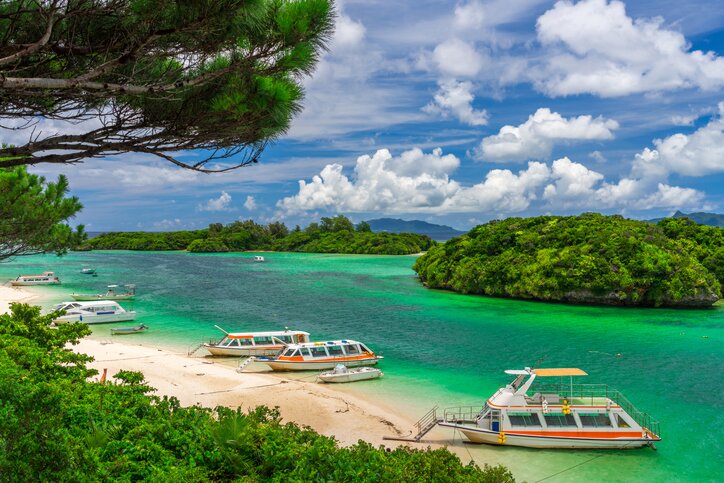Weather
Japan is uniformly hot in July, but conditions do vary from north to south. Sapporo, capital of the northern island of Hokkaido, sees an average July high of 77°F (25°C) and a low of 63°F (17 °C). Almost every major city across Honshu and Kyushu (Tokyo, Osaka, Kyoto, Fukuoka) experiences highs around 86°F (30°C) and lows of 75°F (24°C), so you don't get much respite at night. Average temperatures in Naha, the capital of Okinawa, are similar, although the lows are even warmer.
The good news, though, is that the rainy season typically ends by mid-July. So, while humidity remains high and quite uncomfortable across most of the country, you won't experience as much rain later in the month.
Crowds & Costs
The rather uncomfortable conditions make July a low season for international travelers in most of Japan, with the exception of Hokkaido and Okinawa. Japanese tourists (as well as international ones) head to these places either to escape the heat (Hokkaido) or to embrace it and swim in the sea (Okinawa). When booking travel and accommodation in Hokkaido and Okinawa for July, book as far in advance as possible, and expect high-season prices.
From late July, Japanese schools are on holiday for several weeks, so expect increased crowds at popular amusement parks, beaches, and anywhere that might appeal to young people and families.
Where to Go
While much of Japan swelters in July, you don't have to look very hard to find coastal, highland, or more northern destinations that are more comfortable.
Hokkaido is especially popular as a summer destination because it gets warm rather than unpleasantly hot. The northern part of the island of Honshu, Tohoku, is also cooler than the southern parts of the island, and because it's less densely populated, there are many outdoor attractions to enjoy. The islands of Matsushima, just northeast of Sendai, are a highlight.
Japan is a country of many mountains, and at slightly higher altitudes, you may find cooler temperatures. The Japan Alps are a popular hiking destination and are marginally cooler than other parts of Honshu in July. For a quick escape from Tokyo, the beautiful and culturally important town of Nikko should be a priority, as it sits at a cool 4,258 feet (1,298 m.). If you make a trip farther up to Lake Chuzenji, you may even feel cool.
To enjoy some beach time, either head to the subtropical and tropical islands of Okinawa or find other islands off the coast of the main islands. The island of Iki, accessible from Fukuoka, has gorgeous beaches and mostly Japanese tourists. The Seto Inland Sea, between the three main islands of Honshu, Kyushu, and Shikoku, also has many beautiful little islands worth checking out, such as Naoshima.
Chat with a local specialist who can help organize your trip.
What to Do
Aside from the activities mentioned above, July is the start of the Mount Fuji climbing season, which officially runs from July 3 until September 14. While this is hardly an off-the-beaten-path wilderness experience (there are drink vending machines near the summit!), it shouldn't be taken lightly. Travelers with reasonable fitness and hiking experience will enjoy it most, and the views from the top are worth the effort.
Events in July
Fireworks displays, Nationwide. Through July and August, many cities around Japan put on summer fireworks displays. These can be absolutely spectacular events in larger cities, such as Tokyo. Take a blanket to a park or the banks of a river and expect well-managed crowds and fireworks that just keep going on and on.
Natsu Matsuri, Nationwide. Japanese summer festivals, or natsu matsuri, are held in many towns, cities, neighborhoods, and even small local streets throughout the country, all summer long. These usually include traditional dancing, music and costumes, portable shrines, large crowds, and plenty of food and drink.
Traveling to Japan in July? Check out these great itineraries
Best of Tokyo & Kyoto - 7 Days. This weeklong adventure splits its time between two of Japan's most important cities, offering customizable tours and free time to explore on your own.
Japan Golden Route - 10 Days. This 10-day itinerary follows the path of Japan's ancient Tokaido Highway (the Golden Route) from the skyscrapers of ultramodern Tokyo to the cultural heart of Kyoto.
More Helpful Information
Japan in June
Japan in August
Best Time of Year to Visit Japan
How Many Days to Spend in Japan
A note on diacritical and retroflex markings: In order to support the best technical experience and search functions, diacritical markings have been omitted from this article.
